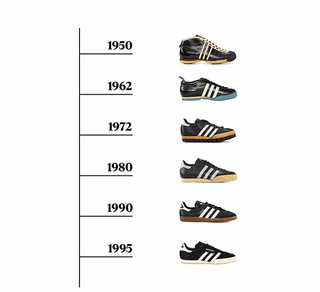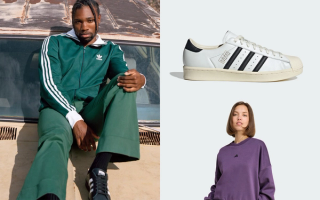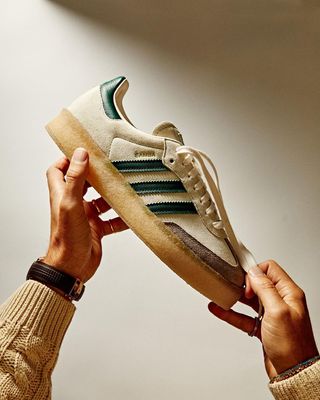Despite its name, the adidas Samba didn't originate in Brazil. Its story, like so many now-iconic silhouettes from the Three Stripes Archives, begins in Germany.
Designed by Adolf "Adi" Dassler in 1949, the shoe made its way onto the scene via an unexpected platform a year later: icy football fields. An answer to the problem of weather-inappropriate footwear during the cold, slippery season, the Samba debuted as a performance-oriented mid-top boot (think adidas Pro Model 2G). Constructed out of premium leather, the innovative design featured rubber reinforcement at the toe, metal eyelets along the tongue, and an outsole with three cut-out suction cups that provided enhanced traction in icy conditions—so much so that players wearing the pair were seen as moving with such grace that their footwear was dubbed Samba after the Brazilian dance form.

The team at adidas refined and improved the Samba over the next two decades. By 1972, the performance-football model had undergone a number of visual changes—namely a lower profile and sleeker forefoot.
Trumped by advancements in footwear for the beautiful game, Dassler's creation was no longer the Three Stripes' marquee football silhouette at the start of the 1980s. And yet, the Samba consistently sold across the globe—particularly in the United Kingdom.
Fans of Manchester United, West Ham United, and other English clubs adopted the low-profile, thin-soled trainer as their match-day uniforms. Beyond the rowdy hooligans that terrorized visiting teams' supporters, folks backing their favorite teams from stadiums' budget-friendly terraces wore the Samba and other similar adidas styles, earning this genre of footwear the "terrace sneakers" moniker.
Between 1990 and the early 2000s, the German sportswear juggernaut had found success in North America through its Running and Basketball divisions. On the fashion front, the adidas Superstar became a crossover hit, resonating with musicians, streetwear enthusiasts, and other niche audiences.
During this timeframe, the Samba became a go-to option for skateboarders, indoor football players, and budget-conscious parents alike. Pairs made appearances in music videos and small-scale films, but enjoyed a quieter life relative to some of its 3-Stripes-branded kin. Its long tongue-variant was a discounted outlet mainstay throughout the late aughts and most of the 2010s, but something shifted heading into the 2020s.

Fashion trendsetters and longtime footballs fans alike began to gravitate towards the adidas Samba at the start of the new decade. Perhaps a reaction to market-saturation of overtly technical footwear, influential figures the likes of A$AP Rocky and Bella Hadid were spotted rocking the iconic T-toe across the globe. Sean Wotherspoon and Jonah Hill signed with the Three Stripes around the same time; their first orders of business included reimagining the silhouette, which they claimed was a favorite from their upbringings.
The Samba's most popular looks were (and still widely are) the "White/Black" and "Black/White" pairs featuring gum brown outsoles. Eponymous imprint, Wales Bonner, tweaked the silhouette through a fashion-forward lens during Fall 2020, cementing it as a style to look out for on the runway. While rooted in her family's Caribbean heritage, Grace Wales Bonner's collaboration showcased just how versatile of a canvas the 71-year-old design was. Projects with Kith, Humanrace, and Sporty & Rich, among others, have followed, expanding the sneaker's legacy well-beyond its football origins.
The adidas Samba was awarded Shoe of the Year at the 37th annual FN Achievement Awards. Over the next two years, the storied silhouette has continued to undergo special makeups by longtime collaborators, all while expanding its inline catalog of ensembles.
The aforementioned two-tone looks continue to dominate footwear rotations everywhere—specifically amongst women—but fans now have a plethora of options to choose from. The taller Sambae provides a familiar, but refreshing look, while the Samba Decon elevates materials and comfort with a collapsable heel. The Samba LT doubles down on the design's sports heritage, donning a long, fold-over tongue that harkens back to some of the brand's most iconic football boots of all-time.
Moving forward, adidas is poised to continue honoring the Samba's history with a healthy mix of classic styles and boundary-pushing collaborations. Pairs, however, will continue to live at adidas.com/Originals, leading the charge for the institution's sports-to-lifestyle catalog.
To shop all available Sambas, visit adidas.com/Samba right now. Pairs are available in sizing for the Kids, Men, and Women, with pricing ranging between $40 (Infant & Toddler Originals) and $150 (Adult's Samba Millennium). Limited edition collaborations vary in price, with some projects retailing for $250.










